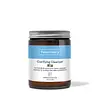What's inside
What's inside
 Key Ingredients
Key Ingredients

 Benefits
Benefits

 Concerns
Concerns

 Ingredients Side-by-side
Ingredients Side-by-side

Water
Skin ConditioningPropanediol
SolventGlycolic Acid 4%
BufferingCetyl Alcohol
EmollientGlyceryl Stearate
EmollientSalicylic Acid 2%
MaskingPolyglyceryl-6 Stearate
EmollientSodium Glycolate
BufferingQuillaja Saponaria Bark Extract
CleansingLactic Acid 1%
BufferingSodium Salicylate
PreservativeCetyl Hydroxyethylcellulose
Emulsion StabilisingGlyceryl Caprylate
EmollientSodium Lactate
BufferingPolyglyceryl-6 Behenate
Emulsion StabilisingCitric Acid
BufferingPotassium Sorbate
PreservativeCitrus Nobilis Peel Oil 0.97%
MaskingWater, Propanediol, Glycolic Acid 4%, Cetyl Alcohol, Glyceryl Stearate, Salicylic Acid 2%, Polyglyceryl-6 Stearate, Sodium Glycolate, Quillaja Saponaria Bark Extract, Lactic Acid 1%, Sodium Salicylate, Cetyl Hydroxyethylcellulose, Glyceryl Caprylate, Sodium Lactate, Polyglyceryl-6 Behenate, Citric Acid, Potassium Sorbate, Citrus Nobilis Peel Oil 0.97%
Water
Skin ConditioningPropanediol
SolventSodium Lauroyl Sarcosinate
CleansingGlycerin
HumectantHydroxypropyl Methylcellulose
Emulsion StabilisingGluconolactone
Skin ConditioningPolyglyceryl-6 Ricinoleate
EmulsifyingPolyglyceryl-4 Caprate
EmulsifyingPolyglyceryl-3 Cocoate
EmulsifyingPolyglyceryl-6 Caprylate
EmulsifyingLactic Acid
BufferingSodium Levulinate
Skin ConditioningXanthan Gum
EmulsifyingSodium Anisate
AntimicrobialSodium Phytate
Aloe Barbadensis Leaf Juice
Skin ConditioningCamellia Sinensis Leaf Extract
AntimicrobialWater, Propanediol, Sodium Lauroyl Sarcosinate, Glycerin, Hydroxypropyl Methylcellulose, Gluconolactone, Polyglyceryl-6 Ricinoleate, Polyglyceryl-4 Caprate, Polyglyceryl-3 Cocoate, Polyglyceryl-6 Caprylate, Lactic Acid, Sodium Levulinate, Xanthan Gum, Sodium Anisate, Sodium Phytate, Aloe Barbadensis Leaf Juice, Camellia Sinensis Leaf Extract
Ingredients Explained
These ingredients are found in both products.
Ingredients higher up in an ingredient list are typically present in a larger amount.
Lactic Acid is another well-loved alpha hydroxy acid (AHA). It is gentler than glycolic acid but still highly effective.
Its main role is to exfoliate the surface of the skin by loosening the “glue” that holds dead skin cells together. Shedding those old cells leads to smoother, softer, and more even-toned skin.
Because lactic acid molecules are larger than glycolic acid, they don’t penetrate as deeply. This means they’re less likely to sting or irritate, making it a great choice for beginners or those with sensitive skin.
Like glycolic acid, it can:
Lactic acid also acts as a humectant (like hyaluronic acid). It can draw water into the skin to improve hydration and also plays a role in the skin's natural moisturizing factor (NMF) in the form of sodium lactate.
Studies show it can boost ceramide production to strengthen the skin barrier and even help balance the skin’s microbiome.
To get results, choose products with a pH between 3-4.
Lower strengths (5-12%) focus on surface exfoliation; higher strengths (12% and up) can reach deeper in the dermis (deeper, supportive layer) to improve skin texture and firmness over time.
Though it was originally derived from milk, most modern lactic acid used in skincare is vegan. It is made through non-dairy fermentation to create a bio-identical and stable form suitable for all formulations.
When lactic acid shows up near the end of an ingredient list, it usually means the brand added just a tiny amount to adjust the product’s pH.
Legend has it that Cleopatra used to bathe in sour milk to help reduce wrinkles.
Lactic acid is truly a gentle multitasker: it exfoliates, hydrates, strengthens, and brightens. It's a great ingredient for giving your skin a smooth, glowing, and healthy look without the harshness of stronger acids.
Read more about some other popular AHA's here:
Learn more about Lactic AcidPropanediol is an all-star ingredient. It softens, hydrates, and smooths the skin.
It’s often used to:
Propanediol is not likely to cause sensitivity and considered safe to use. It is derived from corn or petroleum with a clear color and no scent.
Learn more about PropanediolWater. It's the most common cosmetic ingredient of all. You'll usually see it at the top of ingredient lists, meaning that it makes up the largest part of the product.
So why is it so popular? Water most often acts as a solvent - this means that it helps dissolve other ingredients into the formulation.
You'll also recognize water as that liquid we all need to stay alive. If you see this, drink a glass of water. Stay hydrated!
Learn more about Water